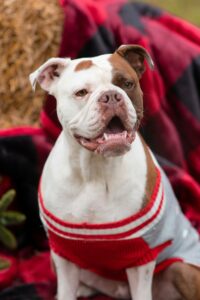Summary:
- Are there any dog breeds that don’t like swimming?
- .Can dogs swim?
- .Dog Breeds That Don’t Like Swimming: The List
- .What are lap dogs?
- .Why can’t some dogs swim for long periods?
- .What to do with a dog that is afraid of water?
- .Are there any dog breeds that love to swim?
1- Are there any dog breeds that don’t like swimming?
Maybe you’ve noticed that your pet doesn’t seem inclined to go near water or, more simply, you’re asking yourself some questions because you’re planning a vacation with your dog and you’re wondering if his is among the dog breeds that don’t like swimming.
Regardless of what your curiosity is, let’s say that yes, there are some dogs that do not appreciate prolonged contact with water . The reasons, however, do not really have to do with personal preference or love: they are more linked to a series of physical, motor, character and even evolutionary reasons.
Now we will explain better, but first we remind you that you can also join our Whatsapp channel for updates and insights on the world of pets, health and well-being and follow the Instagram profile of MypersonalPet , unmissable for animal lovers.
2- Can dogs swim?
- There is no universal answer.
Let’s start with a great truth: although many people are completely convinced that swimming is an innate ability of dogs, in reality it is not exactly like that. A study by the Society for Integrative and Comparative Biology has shown that the only thing shared by all dog breeds is the dog paddle , a swimming behavior that is activated automatically.
Dog paddle is a combined “paddle” gesture of the paws, based on a semicircular movement that can have a certain level of propulsive force based on the resistance of the limbs and the physical conformation of the animal.
The dog paddle is absolutely instinctive and is “activated” when the animal approaches the water or is in deep water: it is a sort of survival response, but while for some breeds it may be enough to trigger the swimming mechanism, for other breeds it is not enough and can lead to a short, tiring and labored floating.
3- Dog Breeds That Don’t Like Swimming: The List
- Affenpinscher;
- Dachshund;
- Basset Hound
- Boston Terrier;
- Bulldog;
- French Bulldog;
- Pug;
- Yorkshire terrier.
- Cavalier King Charles Spaniel;
- Corgi;
- Chihuahua;
- Chow Chow;
- Maltese;
- Pekingese;
- Shih Tzu;
- Pomeranian;
ere is the list of dogs for which dog paddle , although instinctive, is insufficient. The swimming performance of all these dog breeds has been examined in various studies and what has become clear is that not only are they insufficient, but they can also be a source of stress and, certainly, would not allow them to survive for long in conditions of continuous contact.
Most of these breeds share common characteristics such as a short and stocky body , low legs and even very absorbent fur. In addition, it is worth noting the presence of practically all brachycephalic dogs , that is, with a flattened muzzle at the level of the nose and a protruding jaw .
We will see later how these physical peculiarities influence swimming abilities, but first we must also make a small digression from the point of view of the selection and evolution of some specific dogs, namely lap dogs.
4- What are lap dogs?
Historical Purpose and Selection
- Most of the dogs we have listed among the breeds that do not like swimming have been selected over time by man to meet the needs of companionship, especially of the high nobility or the bourgeois class.
Characteristics and Roles
- These breeds (for example the Cavalier King Charles Spaniel, the Pomeranian and the Yorkshire Terrier) were intended to be held in the arms or to lie comfortably on a person’s lap and also had to be temperamentally predisposed to do so. They therefore had to be docile, small in size and even act as “warmers”.
Additional Functions
- Not only that. In some societies (and in times decidedly less attentive to hygiene) lap dogs had the task of attracting fleas, acting as a shield for their owner. Then, with the passing of time, they also became “fashion” accessories, to be displayed in the living room or to be carried around.
Breed Selection and Characteristics
- The selection of breeds therefore went from targeted mating to transmit specific characteristics, including short muzzles, legs, long hair to be styled and increasingly smaller and smaller sizes, until they became almost toys (hence the name Toy).
Evolutionary History and Swimming Ability
- All this may seem really far from the concept of love for animals, but it is part of their evolutionary history and is the reason why many studies (including Physiological Effects of Water Temperatures in Swimming Toy Breed Dogs) demonstrate that toy, lap or couch breeds are not able to swim effectively: it has never been one of their real abilities nor, over the centuries, have they ever felt the need to adapt to an existence that involved contact with water.
5- Why can’t some dogs swim for long periods?
- Paw movements;
- Body movements;
- Physical conformation;
- Respiratory autoregulation;
- Friction of the hair.
Movements of the Legs
- Dog paddle is an instinctive attitude that leads to a specific paddle movement, with the front legs moving in a circle. However, dogs with long legs can also make small movements to maintain balance and direction, which is really difficult for dogs with short legs.
Hind Legs and Propulsion
- At the same time, the hind legs should provide the push to move forward and swim, but their small size does not create sufficient propulsion.
Body Movements
- To swim effectively, dogs should also help themselves with body movements by contracting the back, chest, and tail, but animals such as Pugs, Chihuahuas, and Maltese do not have an adequate muscular structure.
Physical Conformation
- Physical conformation also makes a difference: Basset Hounds, Bulldogs, Corgis, and Shih Tzus (and even Pugs) tend to be round and compact, with unbalanced measurements that do not help them float easily, as demonstrated by the study Swimming Kinematic and Flotation Analysis of Dogs.
Breathing Challenges
- Another crucial point of dogs that “can’t” swim? Breathing. When swimming, the dog usually breathes by exhaling through the nose and inhaling through the mouth, but brachycephalic dogs also exhale through the mouth and, in addition, their neck is so short that it does not allow them to keep their head high.
Fur and Water Absorption
- Finally, as we mentioned, many lap dogs have fur that absorbs a lot of water, which causes the animal to become excessively heavy and sink downwards.
6-What to do with a dog that is afraid of water?
- Don’t force it under any circumstances;
- If necessary, expose it gradually;
- Use games and rewards;
- Don’t increase the depth too much.
If we are dealing with a dog that is physically not able to swim perfectly we should never force him in any way, but if we want him to socialize with water and not be afraid of it, the only thing to do is to expose him gradually , starting with shallow basins or tubs and letting him explore them freely.
Gradually you can encourage him using floating toys or rewarding him with snacks , as well as praising him. However, we do not expect too much from the depth and always try to stay by his side to reassure him.
7- Are there any dog breeds that love to swim?
- Poodle;
- Poodle;
- GoldenRetriever;
- LabradorRetriever;
- Otterhound;
- German Shepherd;
- English Setter;
- Newfoundland
So, just as there are breeds that are not suited or inclined to aquatic activities , there are others that seem to have been truly created to swim. From the Poodle to the Golden Retriever, from the German Shepherd to the Newfoundland, all these dogs are able to move in an excellent and athletic way in the water, thanks to their physical conformation, their body and the power of their legs.










